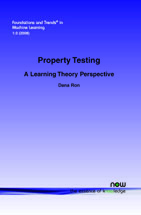Property Testing: A Learning Theory Perspective
By Dana Ron, Department of Electrical Engineering — Systems, Tel-Aviv University, Israel, danar@eng.tau.ac.il
Abstract
Property testing deals with tasks where the goal is to distinguish between the case that an object (e.g., function or graph) has a prespecified property (e.g., the function is linear or the graph is bipartite) and the case that it differs significantly from any such object. The task should be performed by observing only a very small part of the object, in particular by querying the object, and the algorithm is allowed a small failure probability.
One view of property testing is as a relaxation of learning the object (obtaining an approximate representation of the object). Thus property testing algorithms can serve as a preliminary step to learning. That is, they can be applied in order to select, very efficiently, what hypothesis class to use for learning. This survey takes the learning-theory point of view and focuses on results for testing properties of functions that are of interest to the learning theory community. In particular, we cover results for testing algebraic properties of functions such as linearity, testing properties defined by concise representations, such as having a small DNF representation, and more.
Property Testing
Property Testing: A Learning Theory Perspective takes the learning-theory point of view of property testing and focuses on results for testing properties of functions that are of interest to the learning theory community. In particular it covers results for testing algebraic properties of functions such as linearity, testing properties defined by concise representations, such as having a small DNF representation, and more. Property Testing: A Learning Theory Perspective starts with some preliminaries, including a precise statement and proof of the simple but important observation that testing is no harder than learning. It goes on to consider the first type of properties that were studied in the context of property testing: algebraic properties. These include testing whether a function is (multi-)linear and more generally whether it is a polynomial of bounded degree. It then turns to the study of function class that have a concise (propositional logic) representation such as singletons, monomials and small DNF formula. It proceeds to discuss distribution free testing, and testing from random examples alone. Finally, it contains a brief survey of other results in property testing. These include testing monotonicity, testing of clustering, testing properties of distributions, and more. Property Testing: A Learning Theory Perspective is an ideal text for anybody with an interest in property testing and how it connects to topics in machine learning.
